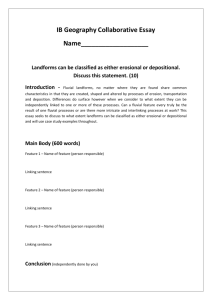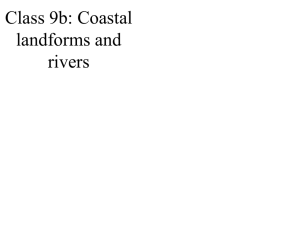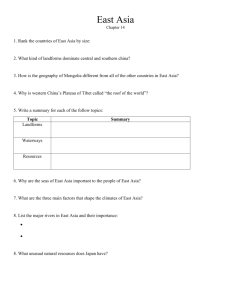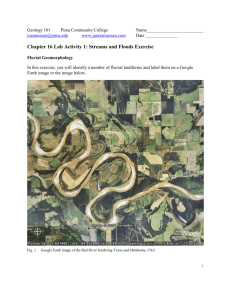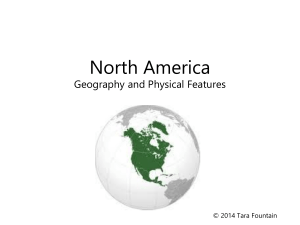Introduction to Fluvial Forms
advertisement
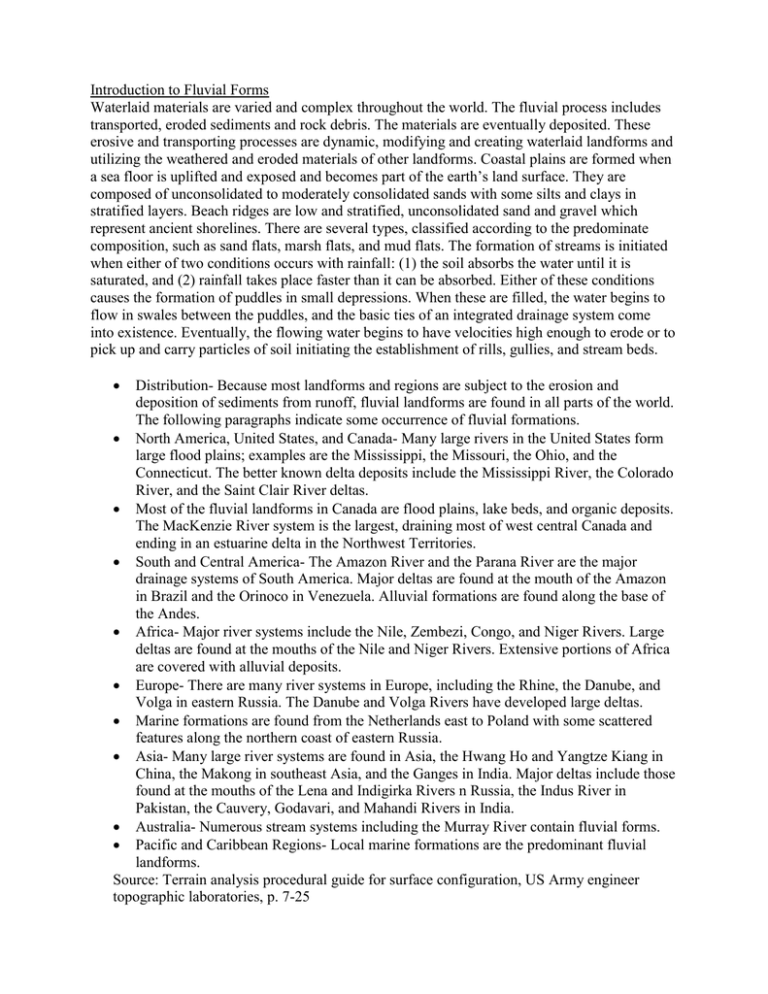
Introduction to Fluvial Forms Waterlaid materials are varied and complex throughout the world. The fluvial process includes transported, eroded sediments and rock debris. The materials are eventually deposited. These erosive and transporting processes are dynamic, modifying and creating waterlaid landforms and utilizing the weathered and eroded materials of other landforms. Coastal plains are formed when a sea floor is uplifted and exposed and becomes part of the earth’s land surface. They are composed of unconsolidated to moderately consolidated sands with some silts and clays in stratified layers. Beach ridges are low and stratified, unconsolidated sand and gravel which represent ancient shorelines. There are several types, classified according to the predominate composition, such as sand flats, marsh flats, and mud flats. The formation of streams is initiated when either of two conditions occurs with rainfall: (1) the soil absorbs the water until it is saturated, and (2) rainfall takes place faster than it can be absorbed. Either of these conditions causes the formation of puddles in small depressions. When these are filled, the water begins to flow in swales between the puddles, and the basic ties of an integrated drainage system come into existence. Eventually, the flowing water begins to have velocities high enough to erode or to pick up and carry particles of soil initiating the establishment of rills, gullies, and stream beds. Distribution- Because most landforms and regions are subject to the erosion and deposition of sediments from runoff, fluvial landforms are found in all parts of the world. The following paragraphs indicate some occurrence of fluvial formations. North America, United States, and Canada- Many large rivers in the United States form large flood plains; examples are the Mississippi, the Missouri, the Ohio, and the Connecticut. The better known delta deposits include the Mississippi River, the Colorado River, and the Saint Clair River deltas. Most of the fluvial landforms in Canada are flood plains, lake beds, and organic deposits. The MacKenzie River system is the largest, draining most of west central Canada and ending in an estuarine delta in the Northwest Territories. South and Central America- The Amazon River and the Parana River are the major drainage systems of South America. Major deltas are found at the mouth of the Amazon in Brazil and the Orinoco in Venezuela. Alluvial formations are found along the base of the Andes. Africa- Major river systems include the Nile, Zembezi, Congo, and Niger Rivers. Large deltas are found at the mouths of the Nile and Niger Rivers. Extensive portions of Africa are covered with alluvial deposits. Europe- There are many river systems in Europe, including the Rhine, the Danube, and Volga in eastern Russia. The Danube and Volga Rivers have developed large deltas. Marine formations are found from the Netherlands east to Poland with some scattered features along the northern coast of eastern Russia. Asia- Many large river systems are found in Asia, the Hwang Ho and Yangtze Kiang in China, the Makong in southeast Asia, and the Ganges in India. Major deltas include those found at the mouths of the Lena and Indigirka Rivers n Russia, the Indus River in Pakistan, the Cauvery, Godavari, and Mahandi Rivers in India. Australia- Numerous stream systems including the Murray River contain fluvial forms. Pacific and Caribbean Regions- Local marine formations are the predominant fluvial landforms. Source: Terrain analysis procedural guide for surface configuration, US Army engineer topographic laboratories, p. 7-25

